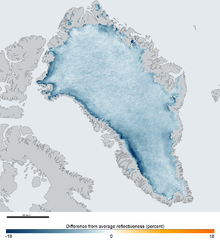Ice-albedo feedback

Ice-albedo feedback (or snow-albedo feedback) is a positive feedback climate process where a change in the area of snow-covered land, ice caps, glaciers or sea ice alters the albedo. This change in albedo acts to reinforce the initial alteration in ice area. Cooling tends to increase ice cover and hence the albedo, reducing the amount of solar energy absorbed and leading to more cooling. Conversely, warming tends to decrease ice cover and hence the albedo, increasing the amount of solar energy absorbed, leading to more warming.[1]
The effect also applies on the small scale to snow-covered surfaces. A small amount of snow melt exposes darker ground which absorbs more radiation, leading to more snowmelt.
The effect has mostly been discussed in terms of the recent trend of declining Arctic sea ice.
Internal feedback processes may also potentially occur, as land ice melts and causes eustatic sea level rise, and also potentially induces earthquakes as a result of isostatic rebound, which further acts to disrupt glaciers, ice shelves, etc.
References
- ↑ Deser, C., J.E. Walsh, and M.S. Timlin (2000). "Arctic Sea Ice Variability in the Context of Recent Atmospheric Circulation Trends". J. Climate. 13 (3): 617–633. doi:10.1175/1520-0442(2000)013<0617:ASIVIT>2.0.CO;2.
See also
- Climate change feedback
- Climate sensitivity
- Polar amplification
- Polar see-saw describes an interesting variant on albedo and cooling.